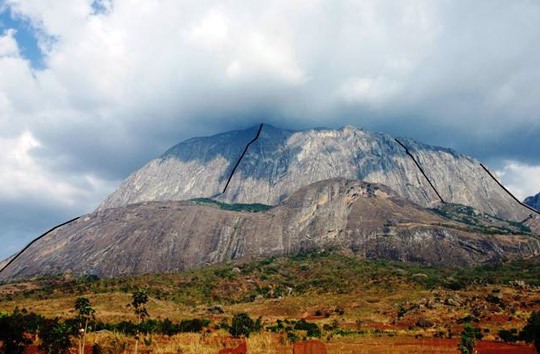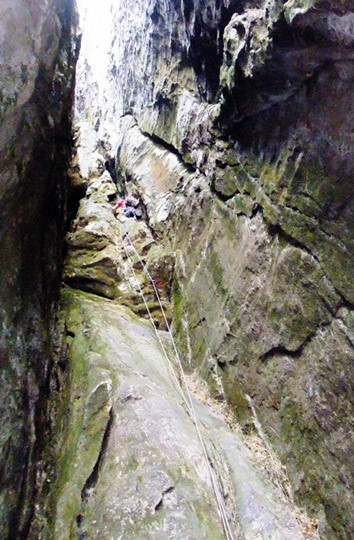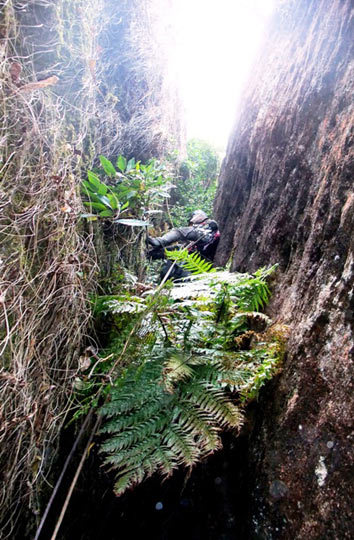
The west face of Chambe Peak, Mulanje Massif, Malawi with known routes marked, from left to right: Northwest Slab Route (not shown), Lower Chambe Face (aka Eastwood Route), Upper West Face Direct (aka Upper Eastwood Route), Nkhalango Khoswe and Roshnik’s Route. [Photo] Jeremy Roop
For young climbers Joe Forrester and Jeremy Roop, the 2,000′ lower wall and 3,000′ upper wall on the west face of Chambe Peak were not the only reasons to travel to Malawi this year.

Jeremy Roop climbs deep inside “Shelob’s Lair” on Nkhalango Khoswe. [Photo] Joe Forrester
With support from an American Alpine Club Mountain Fellowship Grant, the team completed two jungle climbs–first reported in the October 27, 2009 NewsWire–in the Mulanje Massif last month. The first was a free ascent of Lower Chambe Face (aka the Eastwood Route, III 5.10d, 2,000′) that avoided a pre-existing bolt ladder. The second was a new route, Nkhalango Khoswe (IV 5.10, 3,000′), on the wall above. Both climbs were done ground up, onsight and free, save for the occasional “Tarzan vine move.”
Roop and Forrester first became interested in Malawi a year ago when they stumbled across climber Alard Hufner’s website documenting his ascent of the Eastwood Route.
But new routing was not the only purpose for a medical student and future grad student in molecular virology to travel to the area.
“While there are many relatively unclimbed large jungle walls in Africa,” Forrester said, “Malawi was an ideal location to… climb and give something back to the community we visited… The HIV rate is staggering, the health care system is well set up, travel is relatively straightforward and one of the national languages is English.”
After climbing Nkhalango Khoswe, Roop began instituting an HIV treatment protocol for a local nongovernmental organization in Blantyre, Malawi; he will remain there for two more months in support of the project.
The two began their travels in late September. Five days later they arrived at a Scottish mission in Likhubula, where they based operations for the climbs. A local guide showed them how to navigate the four-hour hike from the mission to the base of the Eastwood Route. On October 3, they again made the trek with a rope and light rack and began by soloing the first thousand feet, difficulties reaching 5.7.
“The climbing was surreal,” Forrester said. “Large vellozia bushes and clumps of grass on the face had been recently burned in a large wildfire and we climbed upwards amongst ash and charred trees that lent a very post-apocalyptical feel.”
To avoid the bolt ladder at the crux, Roop led an overhanging fist and offwidth crack at 5.10d that soon returned to more mild terrain.
At the jungle step between the lower and upper walls, they bushwhacked for three hours, avoiding cobras, mambas and baboons known to frequent the area.

Joe Forrester works up a vegetated chimney high on the upper wall. [Photo] Jeremy Roop
A search for crack systems to the north of the Upper Eastwood Route proved unsuccessful. Heading south, however, they found a continuous system left of Roshnik’s route, the only other known route on the face, that appeared both striking and climbable. They stashed climbing gear and hiked off the lower step back to Likhubula.
They returned to their cache on October 6 and bivied at the base of the crack system. The next day they simulclimbed the route’s many easy pitches, mostly 5.5 and up to 5.8. They pitched out what they called “Shelob’s Lair”: an ominous 600-foot 5.10 bomb bay chimney that was crawling with “nasty critters” like spiders and scorpions.
Above the lair they found more vegetated terrain and “loosely adhered vellozia trees that we could lasso for protection” en route to the summit.
They placed no fixed gear on either climb.
Forrester said the area was a magical place to climb, but he admitted that the rock wasn’t exactly splitter.
“What looked like a relatively clean crack system from below turned out to be a nightmarishly vegetated slot for 3,000 feet.” He added that the upper climb required “every jungleneering skill we had.”

Joe Forrester solos through burned vellozias on the Lower Eastwood Route. [Photo] Jeremy Roop